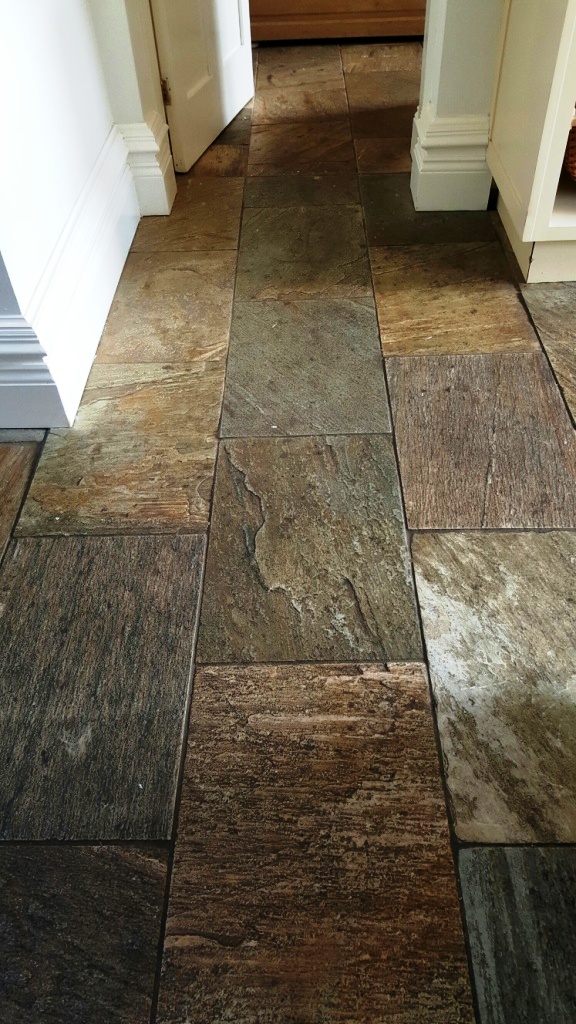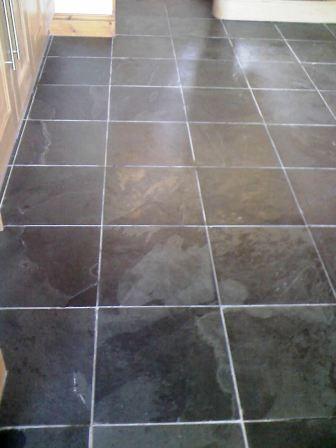

If the slate has been stained, more heavy duty cleaning may be necessary. Then, use a low-pressure cleaner, or a soft sponge or cloth, to wipe down the slate and remove any dirt.

To clean slate, sweeping up lose dirt and debris is the first step in the process.

As such, taking proper care of slate by getting it sealed and cleaning it regularly is important. Additionally, when exposed to certain chemicals – like salt from ponds or chlorine from pools – or when exposed to harsh weather conditions, slate can damaged. When you clean slate flooring or move furniture around, make sure you are extremely careful not to scratch it. If cleaned at a pressure above 800 PSI, slate can spall, and deterioration will be evident. However, it’s not immune to all damages in fact, slate is a very vulnerable stone and, while not easily stained, can be easily scratched. Slate is very stain resistant, meaning that minor spills are typically not a major issue. Slate is a much more durable stone than other common patio tiles, like limestone or travertine. Smooth and flat, and often shiny and colorful, slate is used for roofing, countertops, patio tiles, and more. Formed from clay or volcanic ash, this stone is considered a metamorphic rock that’s characterized by its perpendicular planes and harsh angles, known as stone cleavage. Slate is a combination of the minerals quartz, muscovite, chlorite, hematite, pyrite, and biotite. A silky black that can also range in color from blue-grey to rust and even purple depending upon the stone type, slate is a strong stone that is loved by homeowners and commercial properties alike. If the cork is unfinished or waxed, follow the cleaning instructions for polyurethane but apply solid or liquid wax once the tile is dry.Providing a look of luxury and wealth, slate is one of the most favorite stone choices for both indoor and outdoor needs. Cork Tile: The cleaning care your cork tile needs will vary based on the finish on your tiles. If the cork surface is sealed with polyurethane (most cork floors are), clean with water and mild detergent or white vinegar, then rinse well.To protect your linoleum floors, apply a coat of wax or liquid wax and buff to a shine every 3 to 6 months. After sweeping or vacuuming, wash the linoleum tile with linoleum flooring cleaning solution or Borax detergent and water. Linoleum Tile: Though it's often mistaken for vinyl flooring, linoleum is a very different material that has specific cleaning requirements.Never use an abrasive cleaner or scrubbing tool on vinyl as it may scratch the surface. Simply sweep or vacuum up debris and mop with a vinyl cleaning solution or water and vinegar. Vinyl Tile: This super resilient flooring type is also easy to maintain.Take care of that by drying the floor with a clean, lint-free cloth immediately after washing. Dry the tiles: Don't let your glazed tile floors air-dry as the sitting water will form water spots.You could also try a homemade cleaner with mild acid (such as fresh lemon juice) on ceramic or porcelain tiles (but never on stone tiles). Remove the film with a nonabrasive all-purpose cleaner. Watch for soap residue: If your tiles look hazy even after cleaning, you might be dealing with soapy residue.Use the appropriate cleaner for the stain for the most effective clean. Be on the look for tile stains: If you find a discoloration, first try to determine what type of substance made the stain.Be sure to change the water frequently while mopping dirty water equals a cloudy floor. These mops are best for cleaning tile because sponge mops tend to push dirty water into the grout lines, making them harder to clean.



 0 kommentar(er)
0 kommentar(er)
